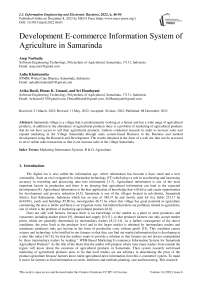Development E-commerce Information System of Agriculture in Samarinda
Автор: Asep Nurhuda, Aulia Khoirunnita, Arika Rusli, Dimas K. Umami, Sri Handayani
Журнал: International Journal of Information Engineering and Electronic Business @ijieeb
Статья в выпуске: 6 vol.14, 2022 года.
Бесплатный доступ
Samarinda village is a village that is predominantly working as a farmer and has a wide range of agricultural products, in addition to the abundance of agricultural products there is a problem of marketing of agricultural products that do not have access to sell their agricultural products. Authors conducted research in order to increase sales and expand marketing in the Village Samarinda through sales system-based Business to the Business and method development using the Research and Development. The results obtained in the form of a web site that can be accessed to serve online sales transaction so that it can increase sales in the village Samarinda.
Marketing Information Systems, R & D, Agriculture
Короткий адрес: https://sciup.org/15018796
IDR: 15018796 | DOI: 10.5815/ijieeb.2022.06.05
Текст научной статьи Development E-commerce Information System of Agriculture in Samarinda
Published Online on December 8, 2022 by MECS Press
The digital era is also called the information age, where information has become a basic need and a new commodity. Such an era is triggered by information technology (IT) which plays a role in accelerating and increasing accuracy in recording and processing data into information [1-3]. Agricultural information is one of the most important factors in production and there is no denying that agricultural information can lead to the expected development [4]. Agricultural information is the best application of knowledge that will drive and create opportunities for development and poverty reduction [4,5]. Samarinda is one of the villages located in sub-district, Samarinda district, East Kalimantan, Indonesia which has an area of 388.37 ha and mostly used for rice fields 233.17 ha (64.04%), yards and buildings 85.80 ha, moor/garden 46.73 ha where this village has great potential in agriculture considering the area is fertile and there is an irrigation route, but behind that there are problems related to agriculture, one of which is the problem of marketing agricultural products [6-8].
Does not side with farmers, because there is no knowledge of the market as a place to meet producers and consumers including market prices [9], demand and supply [10,11], so that producer farmers can only accept market prices which are generally determined by intermediary traders [8,12-14]. As a further consequence of the above conditions, the price limit at the producer level and in the larger market is obtained by intermediary traders and sometimes producers only get income in the form of production costs without profit [15]. This condition causes science and technology to be instilled in our farmers so that they can find out market information that is developing at a time like today [16-18], for that the authors wants to provide a solution so that farmers are not always manipulated by these intermediary traders by making " WEB-Based Marketing E-commerce Information System for Samarinda Agricultural Products” As the title of the thesis that the author will propose where later many traders from outside the region will know about the existence of agricultural products in Samarinda. Then system research web-based marketing of agricultural products aims to So that local traders are not arbitrary in determining the price of the product agriculture because farmers know latest agricultural price information from this e-commerce system. To make it easier for farmers to find information on seeds, fertilizers and methods planting, care and harvesting. This research is expected this system can provide benefits in overcoming agricultural product marketing problems all this time happened by building Marketing e-commerce Information System web- based agricultural products systematic, directed and more efficient farmer's job in marketing the produce their farm.
2. Methodology 2.1 Research design
-
1. Research and data collection (research and information collection).
-
2. Planning
-
3. Product draft development (develop form of product).
-
4. Initial field trials (preliminary field testing).
-
5. Revise the test results (main product revisions).
-
6. Field testing (main field testing).
To be able to produce certain products used analytical research needs and to test the effectiveness of the product so that it can function in society broad, as for the research steps and development as follows [20]:
1. Potential and problems
2. Gathering information
3. Product design
4. Design validation
5. Design improvements
6. Product trial
2.2 Concept Unified Modeling Language (UML)
3. Result and Discussion
3.1 Design development
A use case diagram is a series / description of a group that is interrelated and forms a system that is regularly carried out or supervised by an actor. Use cases are used to shape the behavior of objects / things in a model and realized by a collaboration. Generally, use cases are represented by an ellipse with a solid line, usually contains a name. Use cases describe system processes (system requirements from the point of view of user's view).
Class diagrams are used to show the classes and packages inside System Class diagrams are used to show the classes and packages inside system Class diagrams provide a static picture of the system and the relationships between them. Usually, several class diagrams are created for a single system. Some diagrams will display a subset of classes and their relations. Several diagrams can be made according to desired to get a complete picture of the system being built. Activity diagrams describe the various flow of activities in the current system designed, how each flow begins, the decisions that may occur, and how they ended
Activity diagrams can also describe parallel processes that may occur in some executions. Activity diagram is a state diagram specifically, where most states are actions and most transitions are triggered by completion of the previous state (internal processing) Activity diagram does not describe the internal behavior of a system (and the interactions between subsystems) is exact, but more describe the processes and activity paths from the top level in general. Describes business processes and the sequence of activities in a process. Used in business modeling to show the sequence of business process activities. The structure of this diagram is similar to a flowchart or data flow diagrams in structured design. Very useful when we make this diagram first in modeling a process to help understand the process overall. Activity diagrams are made based on one or more use cases in the use case diagrams.
-
a. Context Diagram
Context Diagram is a level part of Data Flow Diagram that is used to define context and system boundaries in a modeling. This includes relationships with entities outside the system itself, such as systems, organizational groups, and other external data stores. That can be seen at Fig. 1.
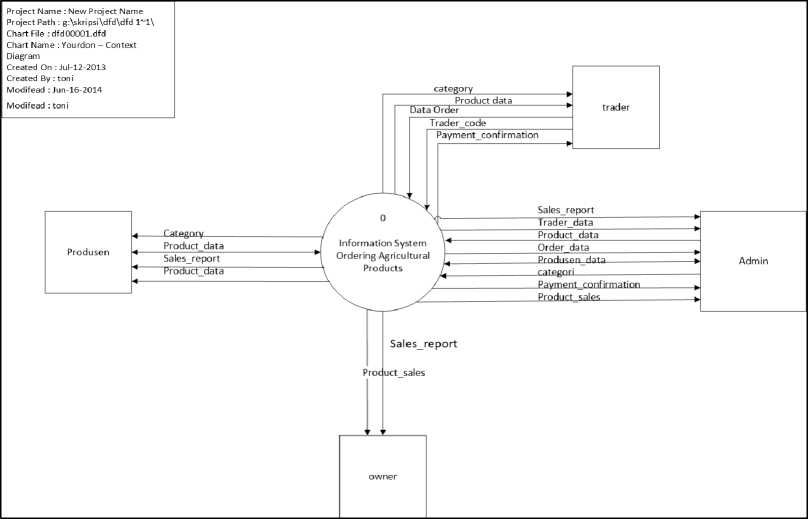
Fig. 1. Context Diagram
-
b. DFD level data collection
DFD is a diagram that describes the flow of data from a process that is often referred to as an information system. The data flow diagram also provides information about the input and output of each entity and the process itself. that can be seen at the Fig. 2.
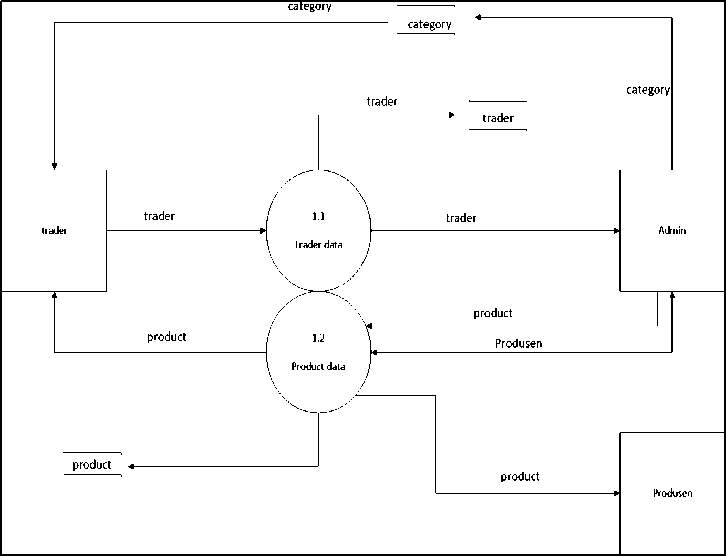
Fig. 2. DFD Level Data Collection
-
c. ERD
ERD is a model or design for creating a database, so that it is easier to describe related or relational data in a design form. With the ER diagram, the database system that is formed can be described in a more structured and neat manner. That can be seen at the Fig. 3.
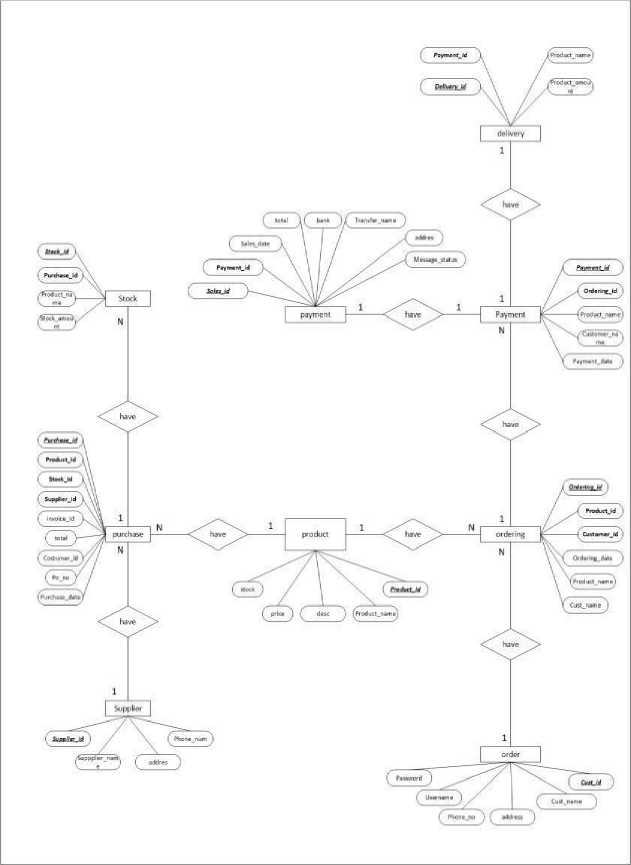
Fig. 3. Entitas Relation Diagram
-
d. System Build
-
3.2 Result of development
This is the proposed information system flow. Sector (trade and administration). Merchants fill in the registration for login which will be stored in the database. After logging in, the merchant can place an order, then the administration section will also log in and make a summary of the merchant's order. After that, the administration will make a delivery report and then provide a note to the merchant. That can be seen at the Fig. 4 (a). The leader makes a report on the expenditure of goods and logs in after getting confirmation from the admin and it will be stored in the database. Then the producer will login and create product data and fill in product data in the database, which can be seen at the Fig. 4 (b).
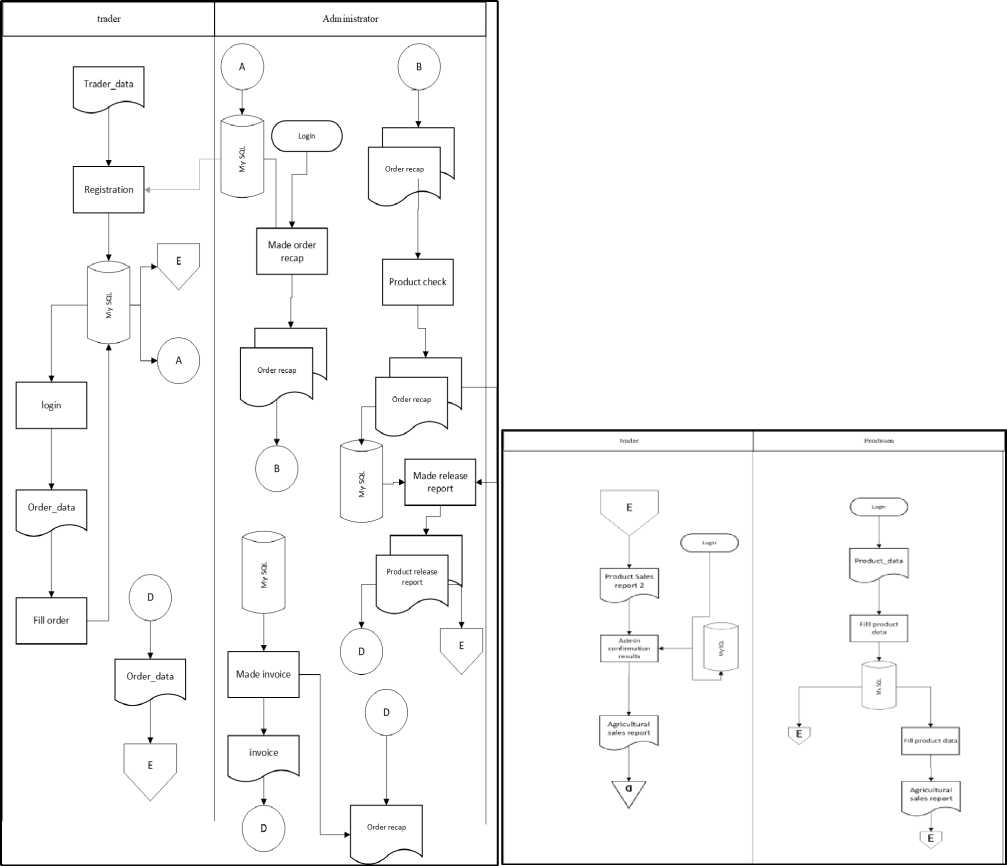
-
a. Main Page Menu View
This is the homepage of the application. You can do something and search. There is a button login, shopping cart, contact us, all products and the other. First you need to login to buy the products. That can be seen in Fig. 5.
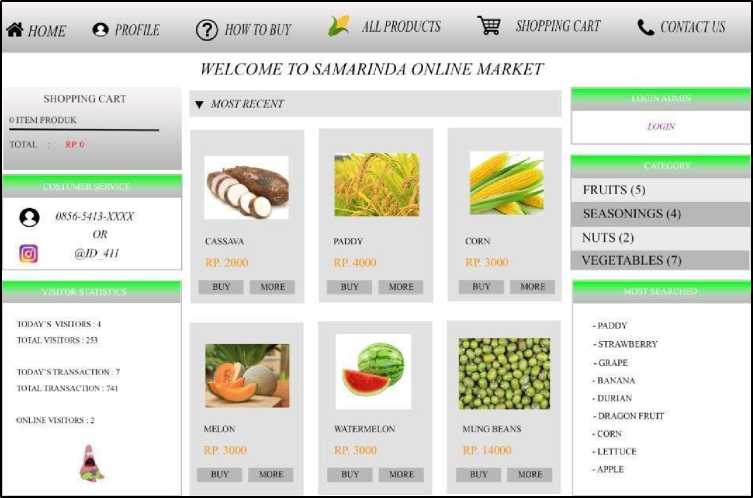
Fig. 5. Main Page View
-
b. Trade Login View
This one is for a trade. They can start to sell if they have login. For login you can fill your email and password and then click login for the next step. That can be seen in Fig. 6.
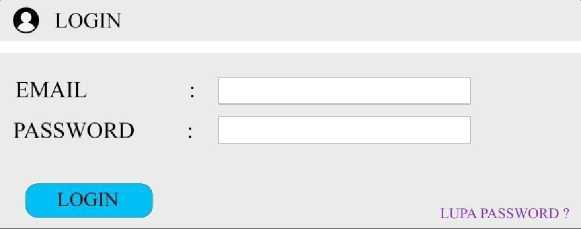
Fig. 6.Trade Login View
-
c. Admin Menu Page View
And this one Is admin menu page view. This for the admin to control the app. Admin can change data and update the products according to the availability. Admin can check what is orders came from buyer. That can be seen in Fig. 7
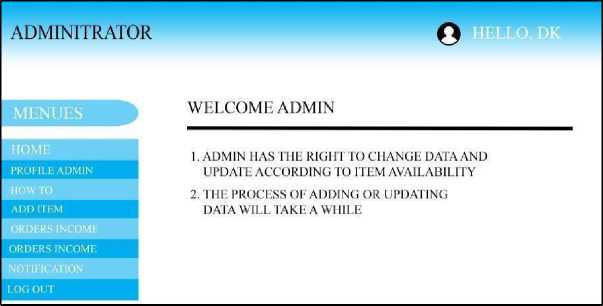
Fig. 7. Admin Menu Page View
-
d. Add product View
Add product view is for administrator to add a new product. Admin can add the name of products, category, weight, price, stocks, the description and photo of the products. That can be seen in Fig. 8.
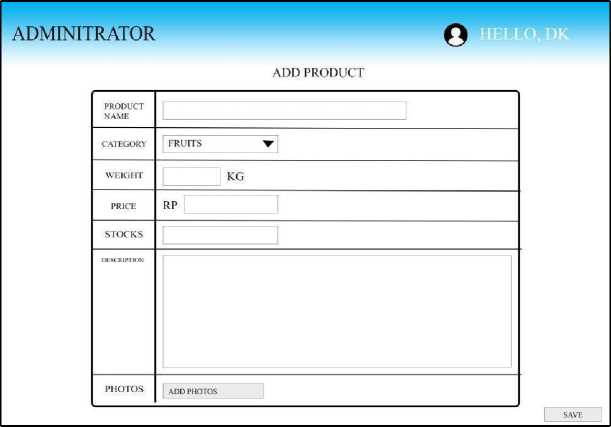
Fig. 8. Add Product View
-
e. Input result view
And the last one input result view. This is after administrator add the products. There is category of the products and description. And you can see how many visitors and today transaction. That can be seen in Fig. 9.
«НОМЕ О PROFILE ©HOIL'TOBUY *~ ALLPRODUCTS ^ SHOPPING CART \. CONTACT US

0 ITEM PRODI IK
FRUITS (5)
SEASONINGS (4)
NUTS (2)
VEGETABLES (7)
M AI L К Mt LUN
STRAWBERRY
TODAY S VISITORS: 4
GRAPE
TOTAL VISITORS: 253
BANANA nils IS JI 1ST ЕХЛMPLE. THIS IS JUST EXAMPLE. THIS IS RIST EXAMPLE.
THIS IS JI 1ST EXAMPLE. THIS IS JUST EXAMPUF. THIS IS JI 1ST EXAMPLE. THIS IS JUST EXAMPLE, THIS IS JUST EXAMP1 ,E, THIS IS JI 1ST EXAMPLE, nils IS JUST EXAMPLE. THIS Is JUST EXAMPLE, THIS IS JUS I EXAMPLE nils IS JUST EXAMPLE. T HIS IS JUST EXAMPLE. THIS IS JUST EXAMPLE. THIS IS JUST EXAMPLE. THIS IS JUST EXAMPLE. THIS IS JUST EXAMPLE. THIS IS JUST EXAMPLE. THIS IS JUST EXAMPLE. THIS IS JUST EXAMPLE. THIS IS RIST EXAMPLE, THIS IS JUST EXAMPLE, THIS IS JUST EXAMPLE, THIS IS JUST EXAMPLE, THIS IS JUST EXAMPLE, THIS IS JUST EXAMPLE, THIS IS n KT EXAMPLE, THIS IS JUSI EXAMPLE, THIS IS WST EXAMPLE,
TODAVSTRANSALTION: 7
TOTAL TRANSACTION : 741
ONLINE VISITORS: 2

THIS IS JUST EXAMPLE. THIS IS JUST EXAMPLE, THIS IS JUST EXAMPLE. THIS IS JUSI EXAMPLE. THIS IS JUST EXAMPLE. THIS IS JUST EXAMPLE. ITUS IS JUST EXAMPLE. I BIS IS JUS I EXAMPLE. THIS IS JUSI EXAMPLE. ITUS IS JUSI'EXAM PEE. I HIS IS JUST EXAMPLE. THIS IS JUSI EXAMPLE, n Ils is JUSI EXAMPLE. THIS Is JUST EXAMPLE, II us IS Jus I EXAMPLE. HUS IS nisi EXAMPLE, THIS IS JUST EXAMPLE. THIS IS RIST EXAMPLE. THIS IS JUST EXAMPLE THIS IS JUST EXAMPLE, THIS IS JUST EXAMPLE, nils IS JUST EXAMPLE. THIS IS JUST EXAMPLE. THIS IS JUST EXAMPLE,
DURIAN
DRAGON FRUIT
LETTUCE
PADDY
Fig. 9. Input Result View
4. Conclusion
With the marketing information system web-based agricultural produce, will be more make it easier for farmers to sell their produce their farms, so that farmers will be more save time and cost in spend to get merchant who will buy agricultural products that they planted, and can be more helpful village government in welfare farmers in the village. With the implementation of information systems, marketing of agricultural products can provide accuracy in the amount of results agriculture, so that make it easier for the government to regulate policies that will be applied to the farmers in the village of Samarinda. With this information system, data agricultural products can be monitored properly, so that when the leader wants to know sales results per period can be reported quit.
Список литературы Development E-commerce Information System of Agriculture in Samarinda
- Ahmad, S. A., Umar, M. M., & Bello, Z. (2017). Integration of Sms and Ecommerce for Nigerian Agricultural System. October 2017, 4–6.
- Alvin, A., & Kurniawan, B. (2019). Electronic Commerce Use of Agriculture for Creating a New Business Opportunity. IOP Conference Series: Materials Science and Engineering, 662(3). https://doi.org/10.1088/1757-899X/662/3/032004.
- Bao, L., Huang, Y., Ma, Z., Zhang, J., & Lv, Q. (2012). On the Supply Chain Management Supported by E-Commerce Service Platform for Agreement based Circulation of Fruits and Vegetables. Physics Procedia, 33, 1957–1963. https://doi.org/10.1016/j.phpro.2012.05.308.
- Bhende, M., Avatade, M. S., Patil, S., Mishra, P., Prasad, P., & Shewalkar, S. (2018). Digital Market: E-Commerce Application for Farmers. Proceedings - 2018 4th International Conference on Computing, Communication Control and Automation, ICCUBEA 2018. https://doi.org/10.1109/ICCUBEA.2018.8697615.
- Cahyo, M. R. D., & Candiwan, C. (2020). Analysis and Design of Sales Information System on Web-Based E-Commerce in Yoga Farm Catfish Breeding Business Using UML. Jurnal Media Informatika Budidarma, 4(3), 683. https://doi.org/10.30865/mib.v4i3.2106.
- Delima, R., Santoso, H. B., Aditya, G. H., Purwadi, J., & Wibowo, A. (2019). Development of Sales Modules for Agricultural E-Commerce Using Dynamic System Development Method. International Journal of New Media Technology, 5(2), 95–103. https://doi.org/10.31937/ijnmt.v5i2.915
- Kang, K.-S., & Corbitt, B. (2002). Effectiveness of Graphical Components in Web Site E-commerce Application - A Cultural Perspective. The Electronic Journal of Information Systems in Developing Countries, 7(1), 1–6. https://doi.org/10.1002/j.1681-4835.2002.tb00038.x
- Lee, R. O., & Nakaji, K. (2011). Development of a web-based video direct e-commerce system of agricultural products. Journal of the Faculty of Agriculture, Kyushu University, 56(1), 109–114. https://doi.org/10.5109/19538.
- Medar, R. A., Rajpurohit, V. S., & Ambekar, A. M. (2019). Sugarcane crop yield forecasting model using supervised machine learning. International Journal of Intelligent Systems and Applications, 11(8), 11.
- Maman, U., & Sugiarti, Y. (2016). The Need of Agribusiness E-commerce to Support Staple Food Self-Sufficiency: The Experience from West Java. International Journal of Applied Agricultural Research, 11(2), 115–128.
- Maman, U., Sugiarti, Y., & Kumaladewi, N. (2017). Design of e-commerce information systems for houseplants: The case of Yasyifa nursery plantation. 2017 5th International Conference on Cyber and IT Service Management, CITSM 2017, 1–5. https://doi.org/10.1109/CITSM.2017.8089298.
- Manikandan, N., Sakthiganesh, M., Kumar, P. J., & Senthilkumar, M. (2012). Web based Farmers Bulletin for agricultural development using PAP Approach. 1, 171–174.
- McKnight, D. H., Choudhury, V., & Kacmar, C. (2002). Developing and validating trust measures for e-commerce: An integrative typology. Information Systems Research, 13(3), 334–359. https://doi.org/10.1287/isre.13.3.334.81.
- Montealegre, F., Thompson, S., & Eales, J. S. (2007). An empirical analysis of the determinants of success of food and agribusiness e-commerce firms. International Food and Agribusiness Management Review, 10(1), 61–81. https://doi.org/10.22004/ag.econ.8168.
- Mueller, R. A. E., Sumner, D., & Clasen, M. (2005). Agriculture on the Web: Current Situation and Prospects for Web-based Commerce and Services. 1–3.
- Nayak, S. N. (2014). E- Transition Challenges in Agricultural Marketing : Key Initiatives in Rural Development.
- Nugroho, H., Hendriyanto, R., & Tisamawi, K. (2018). Application for Marketplace Agricultural Product. IJAIT (International Journal of Applied Information Technology), 2(02), 58. https://doi.org/10.25124/ijait.v2i02.1286.
- Omar, A., Mohamad, O., Marimuthu, M., & Ramayah, T. (2011). Determining Factors for the Usage of Web Based Marketing Applications among Small Medium Enterprises (SMEs) in Malaysia. Journal of Marketing Development and Competitiveness, 5(2), 70–86.
- Sugiarti, Y., Achmad Tjachja, N., Maman, U., Mintarsih, F., Anwas, E. O. M., & Syarifah, E. (2019). Design and Build Mango E-Commerce Information System. 2019 7th International Conference on Cyber and IT Service Management, CITSM 2019, 5–8. https://doi.org/10.1109/CITSM47753.2019.8965402.
- T Abao, J. S. (2020). Peer-to-peer Electronic Buy and Sell Platform for Agricultural Products. International Journal of Advanced Trends in Computer Science and Engineering, 9(3), 3570–3574. https://doi.org/10.30534/ijatcse/2020/163932020.

